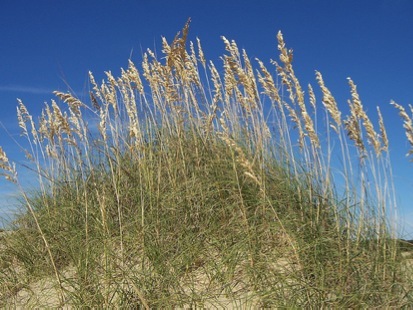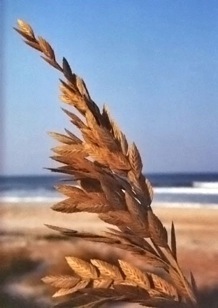Uniola paniculata: Feeling your sea oats
Opinions vary on Sea Oats. Not on flavor. They taste good. The questions are, are they endangered or not, and which genus are they in?
Sea Oats grow in abundance on shores from Texas to North Carolina and are quite edible. They are not on any endangered list but it is illegal to pick them in Florida and Georgia. Why? That is a good debate. They used to be in profusion but like ostrich feathers they were taken for decoration. While their number have dropped they are not really endangered per se.
However, they are a desirable coastal plant –Sea Oats stabilize sand dunes — so they are talked up as endangered. They grow right up to the high tide mark and spread by underground rhizomes. Actually Sea Oats trap wind-blown sands that eventually mound to begin dune formation. A pioneering plant, they rapidly colonize and tolerates sea water and salt spray. They tend to be invasive via the root system but their seeds are often not viable. That should ease your conscience should you take some seeds to plant at home.
More so, any one who has studied beaches know beaches are in constant change and it is doubtful one species will halt the influence of the sea. In that beaches are always moving then perhaps Sea Oats are “endangered” just like beach houses are “endangered” but they are not endangered in the legal sense of the word. However, the official position is that this common plant is “endangered.” Consider eating them in those two states only if your life is “endangered.” One compromise is buy some roots/seed and grow your own. They will flourish in your sunny back yard just as well as they will at the beach. Sea Oats grow to about eight feet high, are highly drought tolerant, and quite showy.
Botanically they are Uniola paniculata (you-NYE-oh-luh pan-nick-yoo-LAY-tuh.) Uniola means one because the plants bracts are united. Paniculata refers to the plant’s flower clusters in panicles. The grain was eaten by several native Indians, as was U. virgata (Limestone Grass) found only in the Caribbean. Virgata (vir-GA-tuh) means wand and the plant, unlike the U. paniculata, has a tight spike at the top. U. palmeri, now called Chasmanthium latifolium, is found inland in many US states. See separate under Wood Oats. ) Sea Oats are sometimes called Chasmanthium paniculata but whether they are in the genus Chasmanthium or Uniola is a botanical teapot tempest.
Uniola paniculata and Chasmanthium latifolium have so many common names I made the decision here to call them by where they grow, Sea Oats because they grow by the sea and Wood Oats because they grow in woods. It makes things a lot easier to remember.
Green Deane’s “Itemized” Plant Profile
IDENTIFICATION: A perennial grass, creeping roots, stout stems, found in dense clumps 3.5 to 8 feet high, leaves long and skinny, tapering, slender tips curling like a ribbon, spikelets flat, oval, straw colored, clustered panicle, eight to 16 inches long, flat seeds enclosed.
TIME OF YEAR: Nearly year round
ENVIRONMENT: Sandy beaches and dune
METHOD OF PREPARATION: Seeds can be cooked as cereal, or ground and made into bread.




A couple of days ago I selected this plant from the Park Seed people (they call them Northern Sea Oats) because it looked like a good choice for really hot, dry weather as well as year round (almost) here in NW AR. Looks like a very good choice for a screening plant as well.
Do you have a feel for how much grain would be produced on a given plant or say a row of 40 ft? I’m interested in household grain production and this looks like a possible option, to go with my already established gamagrass stand.
I had boughton one plant at a native sale. This year I expanded my garden and the newly till area grew a lot of it. I dont know how much could be harvested but my ducks love it. They strip off the seed head and then eat the stem down to a few inches. I’ll be trying to get more to grow and get a better idea of what if any real feed could be grown.
@Luane Todd : We have Sea Oats in our yard in Colorado Springs. They ARE very invasive. We cultivate and grow it for xeriscape ground cover. The seed stalk is not great enough to grow this for household production. At best, it would be an “accent grain.” The quantity of plants required to gather any appreciable amount of grains would be extremely massive, as the number of plants we have (with the corresponding low amount of grain) is considerable.
Can anyone advise a good place to buy sea oats that will ship to NC?
I have seed if u wish to get some. I am in NC
Hi Jim,
I only paint sea oats in my paintings of the ocean.
Just wondering, are the same Jim Wilson that was at WPJS-FM back in the late 70s? Jim Wilson taught me radio. He hired me as an on-the-job trainee, for 30 days, then not long afterwards, he moved on.
Not unusual for DJs…anyway, if you are that same Jim, would love to hear from you.
Best wishes for getting the oats!
I purchased some sea oats from a local wild plant nursery here in the Tampa Bay area. They are in my yard now, and I would like them to spread. Any thoughts on how I might help them along a bit?
Strip the heads once they are golden and dried some. My ducks eat it in not protected. Then it says the rhizomes should spread as well during the following years. I have no idea how thick it can or will grow in yet.
How can I stop them from spreading and blocking my view of the water at my beach house?
Eat them but that is illegal.
Is it legal for them to be foraged in Texas and shipped to North Carolina, or are there additional regulations governing this kind of situation?
Wood oats are not protected.
How is it best to grow the seed from sea oats? I have some little planter cardboard containers. Type of soil to use, watering, etc.
Thank you so much. I live on Dauphin Island, Alabama
Live in New Smyrna Beach, FL want to know where I can purchase sea Oates that are salt water tolerant to help protect our beach from further erosion
Thank you
Has anyone used sea oats to make beer??
Sea oats are protected but their close relative Wood Oats are not.
Hello. I am looking for a way to prepare sea oats in a meal or treat (If they are not endangered in Florida of course). I heard a rumor you could make sea oat bread and was wondering if there are any recipes out there I could try out. Thanks!
What about Sideoats Grama? I’m struggling to buy sea oats for my house (because so far I have to order at least 1000 due to the site being a wholesaler) so I figured I would use Sideoats Grama instead. They would be for the same purpose as sea oats: erosion control on my sandy yard… but I can’t find info on whether or not the seeds on the Grama are edible for humans. The internet is talking them up for livestock… but what about humans?